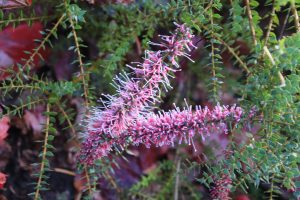Eucalyptus SG newsletter, No.73, May 2022
Several recent articles are reproduced which tell of developments with the rarest Eucalypt species in the Sydney area, Eucalyptus sp. “Cattai”. Sample material has been collected from locations where is is threatened, and it is being propagated for planting in secure locations.
Specimens of Eucalyptus regnans, the mountain ash, are among giant trees threatened by logging in Tasmania. A Big Tree Register has been created as an open-source public record to document to location of the tallest trees.
Lidar is a laser-based mapping technology which together with a software application, is now in use to survey forests. One specimen of swamp gum in Tasmania, nicknamed “Centurion” has been measured as the world’s tallest flowering plant at 99.6m in height.
Fern Study Group Newsletter No. 151, May 2022
The group is planning a Fern Gathering to be held in the Port Macquarie area from 4-7 November. The newsletter reports on the Sydney group’s trip to Mount Wilson, where the notable find was Lindsaea trichomanoides. The SE Queensland meeting hiked to Springbrook Trig on the southern end of the Springbrook Plateau, where they were able to observe Arthropteris palisotii, now thought to be part of a disjunct southern population of this fern better known from the wet tropics. Intrepid members on the excursions encountered wet conditions, good for ferns but not optimal for walking or driving! Rod Pattison provides a historical article on Drynaria rigidula “Whitei”, recorded in the Glasshouse Mountains in 1910. Dwayne Stocks and Peter Hind report on Doodia x Blechnum (Oceanopteris) hybrids.
Grevillea SG newsletter, no.122, June 2022
The newsletter reports on a population of Grevillea renwickiana occuring between Nerriga and Mongarlowe. G. renwickiana, which belongs to the holly leaf group of prostrate grevilleas, is a sterile species reproducing by runners. Alf Stephens describes his hunts for subspecies of G. pauciflora on Eyre Peninsula, S.A., which have extended over a number of years. Other newsletter items report on grevillea sightings in the wild in W.A. and Victoria. Helen Howard writes of the impact of climate change on the nursery industry, and mentions that a number of grevillea hybrids have proven resilient, eg “Semperflorens” “Flora Mason”, “Red Sunset” and “Lemon Supreme”. G. olivacea is a tough parent. A mix of 75% species to 25% hybrids is recommended.
Hakea SG newsletter. no.79, June 2022
Members are reporting issues with recent exceptional rains impacting on their hakeas. This has included Eastern species. Beds may need to be raised or drainage improved as most hakeas do not tolerate wet conditions around their roots.
Small hakeas for gardens are described, including H. myrtoides, H. costata, H. conchifolia, H. smilacifolia and others.

Correa Study Group Newsletter No.64, June 2022
Bob and Dot O’Neill report on late autumn flowering correas, noting however that one or more correas will be flowering at least lightly at any time of year. Correa pulchella “Remarkable Rocks” has responded well to watering, pruning and fertilizing. Linda Handscombe gives an account of Correa reflexa var reflexa “Granny’s Grave”, a Victorian coastal form. At the location where it was discovered, it is hanging on in a remnant patch which was fenced off. Neil Marriott summarizes the distribution and many forms of the Grampians Correa, Correa reflexa va angustifolia. This will be one species featured in the WAMA Botanic Gardens being established just outside Hall’s Gap in the Grampians, with several lovely plants providing a mass of vibrant red flowers during late summer-autumn. A practical tip from the editor for gardeners – wire and propylene plant labels which sit above the plant. Both magpie and mower proof!
Wallum and Coastal Heathland SG newsletter, no.53, July 2022
Leader Allan Carr and members are compiling a list of wallum plants. A list is in the process of being compiled of the remaining wallum and heathland sites in southeast Queensland. The group has a program of monthly walks. The newsletter’s feature plant is Utricularia lateriflora, the tiny bladderwort.
